
Deep Dive into the Grasshopper Pose: A Yoga Guide to Mastery
Welcome! I’m Dav Jones, a yoga practitioner and teacher committed to guiding students to embody their yoga practice from their own innate authenticity. Today, we’re exploring one of yoga’s more intricate arm balances: Grasshopper Pose (Parsva Bhuja Dandasana). This advanced asana fuses rotation, strength, mobility, and refined proprioception into one powerful posture.
Whether you’re beginning your journey with arm balances or refining advanced transitions, this guide offers a comprehensive breakdown—from biomechanical foundations to advanced integrations and modifications.
What is the Grasshopper Pose?
Grasshopper Pose is a side-oriented, asymmetrical arm balance that requires:
- Axial rotation (twisting) of the spine
- External rotation and flexion of the hip
- Strong scapular stabilization and isometric adduction of shoulders
- Dynamic core recruitment and neuromuscular control
The pose transitions from a deep spinal twist (often from a ‘Figure Four’ posture) into a balance supported entirely by the upper limbs, with one leg externally rotated and the foot gripping the upper arm whilst the other leg is adducted and extended laterally. The body forms a dynamic cross-body structure—requiring strength, suppleness, and a deep internal steadiness.
Benefits of the Grasshopper Pose
Physical Benefits
- Strengthens Upper Body & Core
Requires isometric contraction of the pectorals, anterior deltoids, triceps, and deep core stabilizers like the transversus abdominis and obliques to lift and sustain the pose.
- Improves Hip Mobility
Deep external rotation and flexion of the front hip challenges range in the gluteus medius, piriformis, and adductors, encouraging pliability and control.
- Enhances Spinal Mobility
Requires controlled axial rotation of the spine, activating thoracic mobility and stretching fascial lines along the obliques, erector spinae, and latissimus dorsi.
- Develops Scapular Stability & Wrist Strength
Sustaining weight through the hands requires serratus anterior activation, wrist extension strength, and fine motor control in the fingers and forearms.
Mental Benefits
- Enhances Focus & Proprioception
Engages the sensorimotor cortex through balance, body awareness, and inter-limb coordination. - Cultivates Resilience & Mindfulness
The posture is a real-time feedback system, inviting you to adapt, adjust, and stay centered through the experience of the posture.
Step-by-Step Technique Grasshopper Pose (Parsva Bhuja Dandasana)

Seated ‘Figure Four’ Pose – A great preparatory pose Grasshopper
Preparation – Prime the Body
Focus on poses that mobilize the hips, prepare the spine for a deep twist, activate core engagement, and prepare the wrists and shoulders. Ideal warm-ups include:
- Lizard Pose (Utthan Pristhasana) – for hip flexors and external rotators
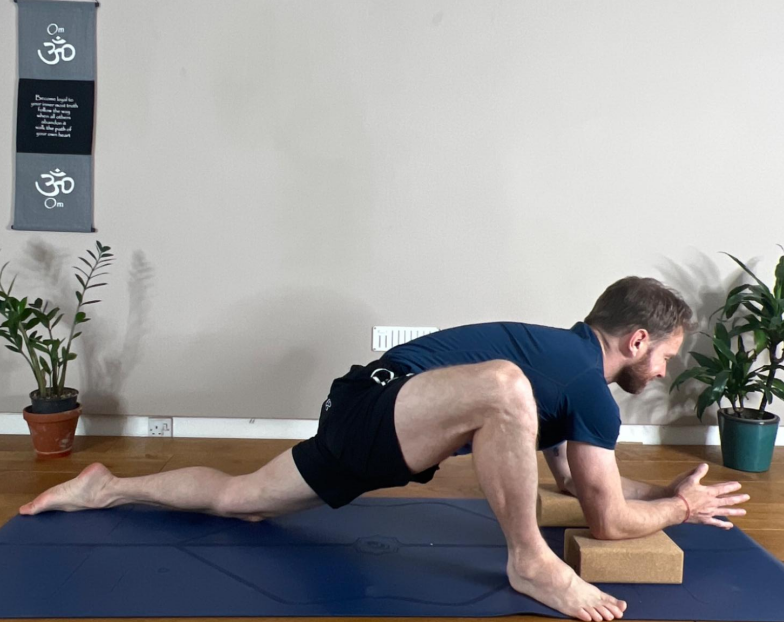
- Revolved Pigeon Pose – opens the hips and rotates the thoracic spine

- Revolved Chair (Parivrtta Utkatasana) – to awaken thoracic spine rotation
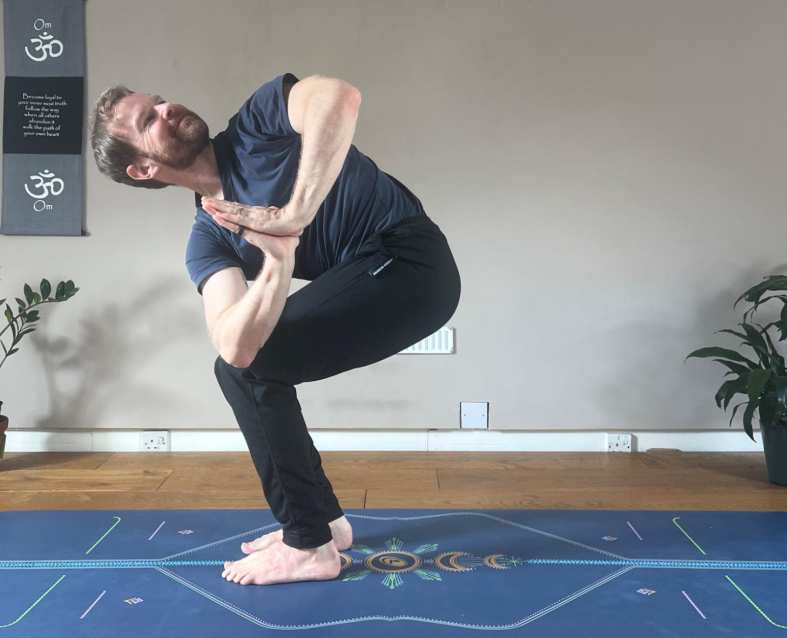
- Boat Pose (Navasana) – to activate the deep abdominals and hip flexors
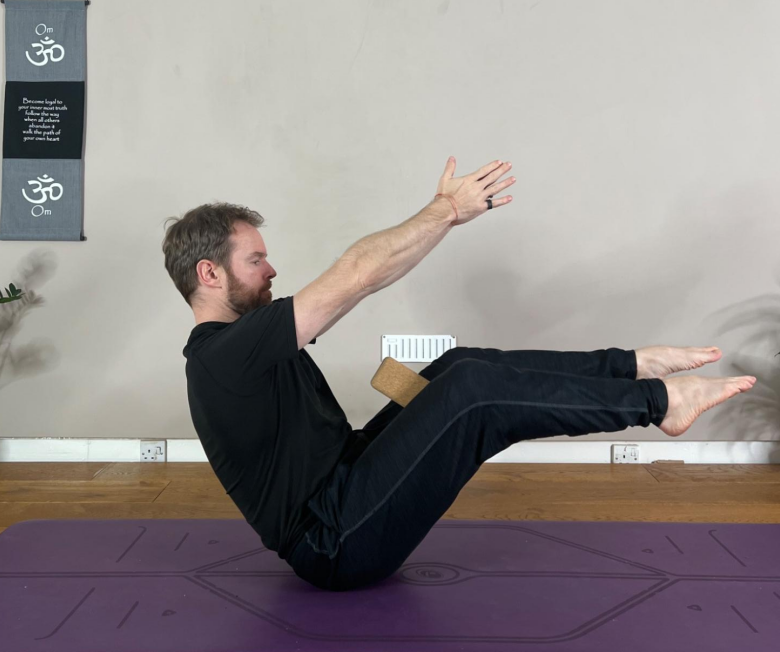
Execution
- Start in Chair Pose (Utkatasana)
Feet together, knees bent. Lift through hip flexion and maintain neutral pelvic tilt. Arms overhead in shoulder flexion.
2.Move into Standing Figure Four Pose
Cross the ankle of the right over your left thigh just above the knee.
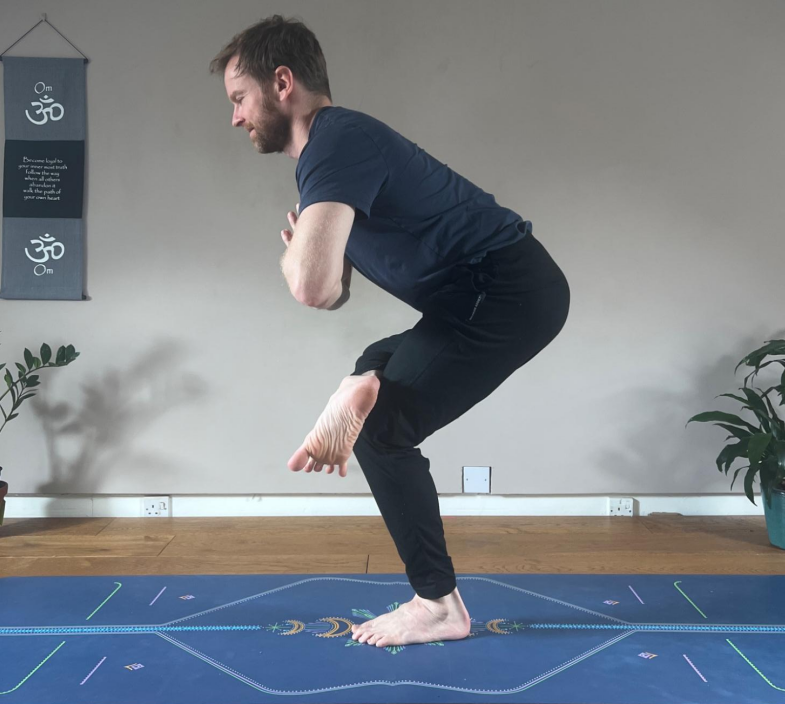
3. Add the Twist
Bring palms together at the heart. Rotate the thoracic spine to the left, rotating from the mid-spine, not the lumbar. Hook the right upper-arm on the sole of the right foot, pressing the upper-arm against the foot and the foot against the upper-arm facilitating a twist through the spine.
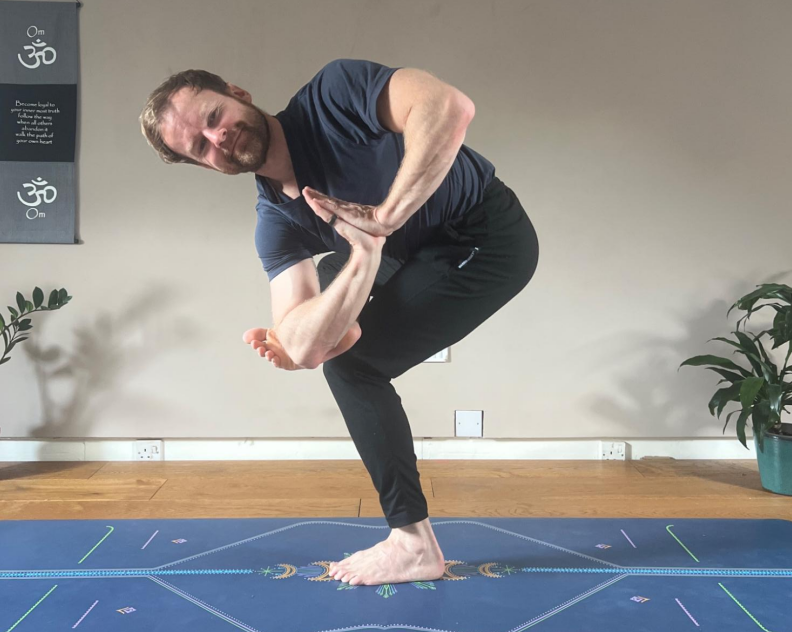
4. Plant the Foundation
Lower your hips and bring both hands to the floor beside the right foot. Hands shoulder-width apart, fingers actively spread.
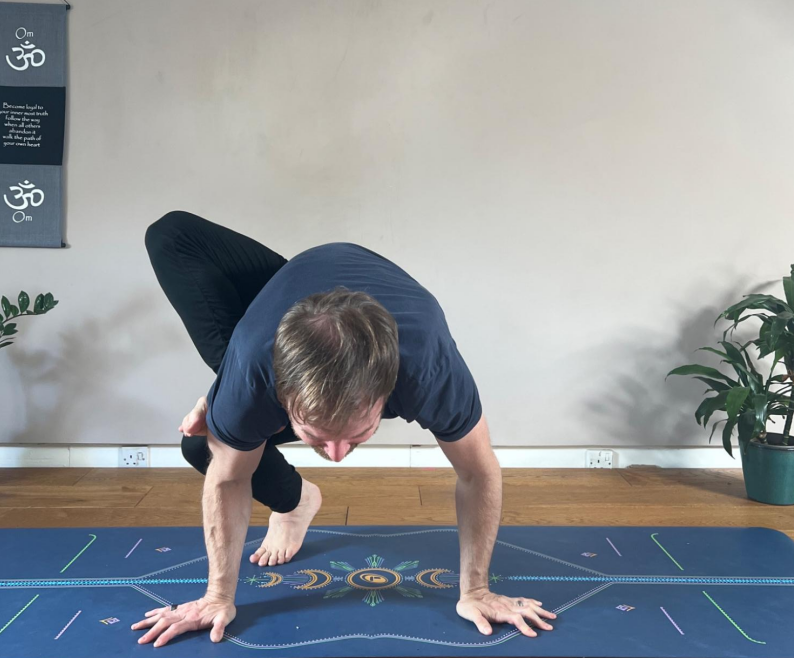
5. Grip the Arm
Grip your right foot over your upper right arm. Start shifting weight into your hands and lean your shoulders forward.
6. Extend Leg and Balance
Begin to extend your left leg out to the side for the full Grasshopper pose. Lift your body and hold, engaging your core and keeping your breath steady.

7. Exit with Control
Slowly release the pose by lowering the legs and returning to a squat, then unwind to standing.
Key Anatomical Cues
- Gaze forward: Trains vestibular stability and head-neck alignment.
- Draw the navel to spine: Activates transversus abdominis and deep core stabilizers.
- Legs pull, arms push: Creates a closed kinetic chain of tension for better lift and stability.
- Spread the fingers: Increases surface area and neural feedback through the palmar fascia.
Common Challenges & Biomechanical Solutions
1. Loss of Balance
- Root cause: Inadequate load transfer from legs to hands; unsteady spinal twist
- Fix: Use a block under your hands to increase elevation and allow cleaner weight shift. Keep the twist active and pelvis square until the lift feels intuitive.
2. Limited Hip Mobility
- Root cause: Insufficient external rotation and flexion range
- Fix: Practice Pigeon, Lizard, and 90/90 drills to isolate and stretch piriformis, gemellus, and gluteus minimus.
3. Wrist or Shoulder Strain
- Root cause: Weak scapular support and/or poor wrist alignment
- Fix: Warm wrists with tabletop pulses and plank variations. Strengthen serratus anterior with Dolphin Pose and forearm planks. Use a wedge or rolled towel under the heels of the palms to reduce wrist extension.
Modifications and Advanced Options
Modifications for Beginners
- Half Grasshopper: Keep the extended leg on the floor, focusing on the position of the legs and hips. This variation takes out the strong twist and allows the practitioner to focus on the lower body position.
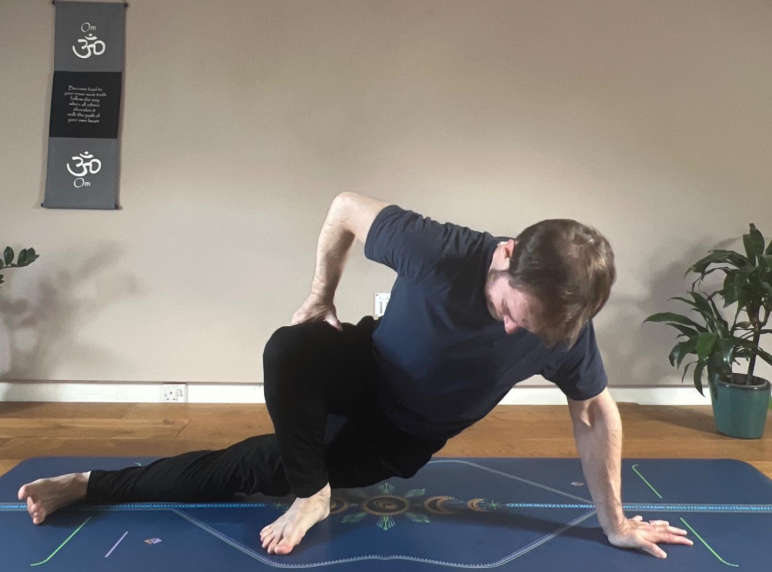
- Use Blocks: Hands on blocks reduces compression and increases lift.
- Chair Twist: Focus purely on the spinal rotation before attempting any load-bearing.
Advanced Variations
- Extended Holds: Build muscular endurance by maintaining the pose for 5–8 breaths.
- Integrated Vinyasa: Transition into Grasshopper from Revolved Chair and exit into Eka Pada Koundinyasana II (EPK II)
- Arm Balance Sequencing: Combine Grasshopper with other arm balances using core-to-extremity transitions.
Integrating Grasshopper into Your Yoga Practice
This pose makes a strong peak pose for classes focused on:
- Twists and side-body activation
- Core strengthening
- Arm balance progressions
Pair it with:
- Flying Pigeon (Eka Pada Galavasana)
- Side Crow
- Lizard and Dragon pose variations
Use it to cultivate not just skill—but resilience, focus, and self-mastery.
The Grasshopper Pose fits beautifully into intermediate-to-advanced sequences. Add it after deep hip openers, spinal twists and standing balancing poses. Combine with:
- Bird of Paradise
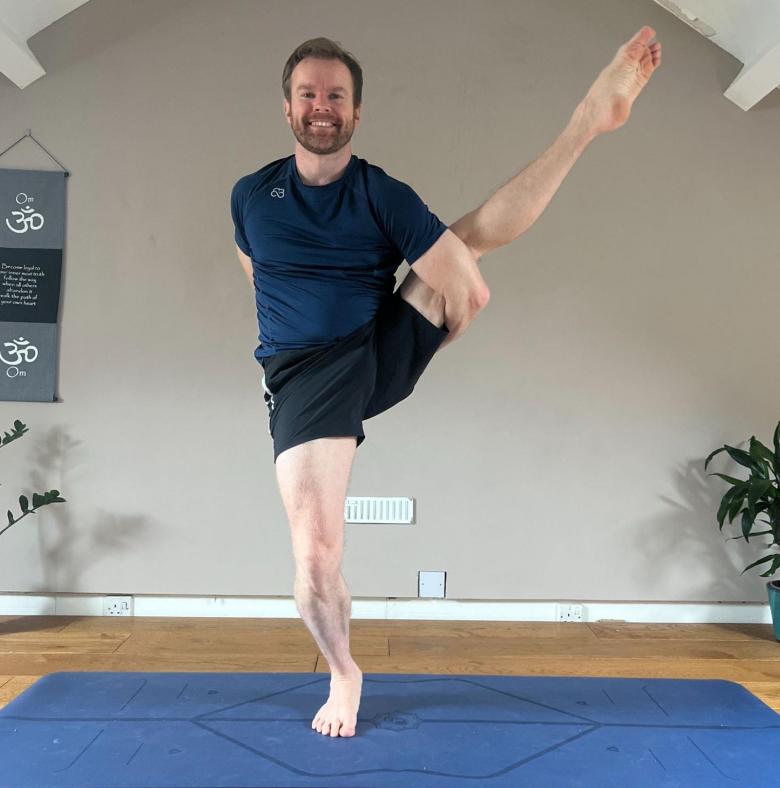
- ‘Road Kill’ – A prone version of ‘Half Grasshopper Pose’
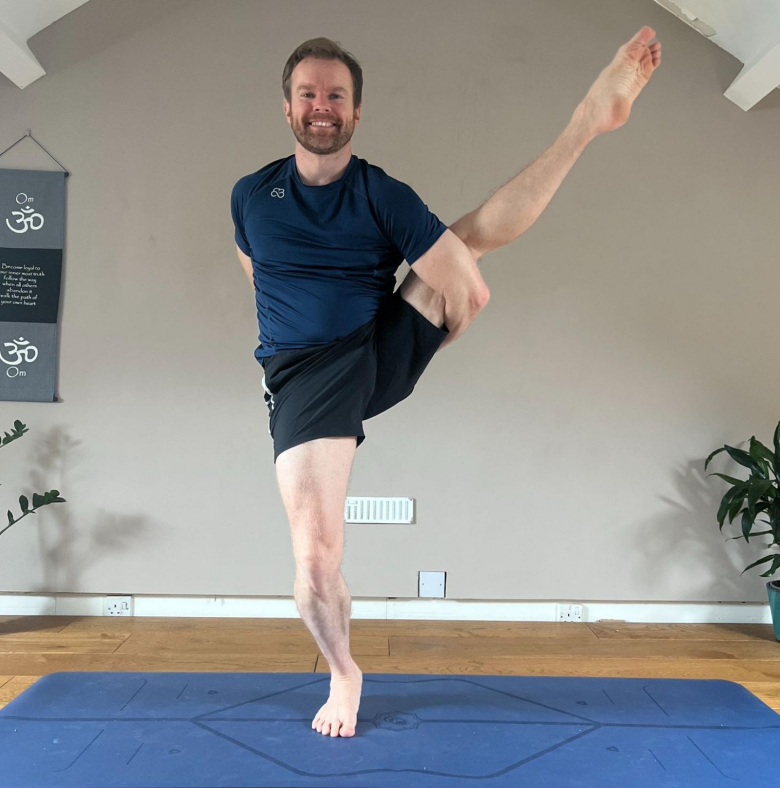
Final Thought
Grasshopper isn’t just about mastering an arm balance—it’s about developing integrated movement, neuromuscular coordination, and mental clarity. It invites you to move with intent, breathe with awareness, and rise—again and again.
Every fall teaches you something. Every lift reminds you what you’re capable of.
Want to Go Deeper?
I offer step-by-step breakdowns of poses like this on my Patreon channel, where you’ll find guided flows, pose tutorials, and exclusive video content.
And if you’re looking for personalized mentoring, join the DJY Mentorship Program—a 1-to-1 program designed to support your personal growth and yoga goals. Let’s take your practice to the next level together.









